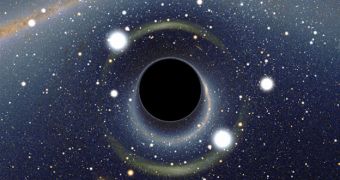Physicists have recently taken a great deal of interest in tiny-mass black holes, constructs that are many orders of magnitude smaller than their supermassive counterparts inhabiting the cores of large galaxies.
Studies focused on microscopic black holes hope to tease out more data about how the structures form and evolve over time, as well as about how heavy they actually are. The largest such structures can tip the scales at billions of solar masses, but the weight of microscopic ones is still a mystery.
One could easily argue that the smallest black holes are of little importance, since they can't gulp up planets and stars. Experts explain that studying these formations is critical towards understanding the Big Bang and the period shortly after.
Objects such as these may still be permeating the Universe to this day, and validating their existence could provide an elegant explanation for why the Cosmos is missing a large amount of its mass.
Physicists say that another important reason for studying microscopic black holes is the fact that they could inadvertently be produced by particle collisions at the Large Hadron Collider (LHC) particle accelerator, underneath Geneva.
German investigators at the Ludwig-Maximilians-Universitat in Munich, led by expert Gia Dvali, have recently begun such a study, Technology Review reports. The team believes that black holes can form at this tiny quantum scale.
What this implies is that their masses can be quantized, and this is why the new work is being led. However, the team must first find out what factors influence the quantization of a black hole's mass.
This could be done in fundamental Planck length, but no one can be sure just yet, given that the structures can literally spring in and out of existence. Scientists say that the LHC could produce black holes in their lowest quantum state at first, but that more energetic collisions could reveal higher states as well.
However, in order to “uncover the precise form of the quantization rule for lowest black hole resonances, we need more experimental input,” Dvali explains. The expert admits that the new study could be interpreted as suggesting that the LHC is now safe.
A lot of debate has plagued the construction effort, with some saying that microscopic black holes would be produced at the particle accelerator following proton and lead nuclei collisions. The 3,000+ physicists working on the experiment argued that these concerns are unfounded.

 14 DAY TRIAL //
14 DAY TRIAL //